We follow fashion trends. Do-it-yourself flower beds and garden compositions in the country: rules for competent design
We are VKontakte
Do it yourself for a summer residence
Equipment and inventory
Ideas for giving by mail
By clicking on the button you consent to the processing of your personal data
Country recipes
Peppers in gelatin for the winter, recipes with photos
Peppers in gelatin, prepared for the winter, will be an amazing and original snack not only on the menu for guests, but also for a morning breakfast or lunch. Moreover, the recipes involve the preparation of jelly on […]
How to prepare pepper for the winter - 3 ways
There are many ways to prepare pepper for the winter. Each of them has its own advantages, and also allows you to preserve this product for certain purposes. In addition to targeted methods - cooking […]
How to pickle hot and bell peppers for the winter
There is an opinion that home canning is a rather laborious process that requires special equipment, time and patience. This is common with many foods, but not with pickled peppers. This article offers 2 pickling recipes […]
Pickled radish for the winter, have you tried this?
Radish is a very unpretentious and very healthy vegetable that can be grown almost all summer. Due to the fact that the radish crop ripens quickly, it can be grown every 3 weeks, and with a weekly […]
Soaked apples recipe at home
Urination, like salting and pickling, primarily has important functions of preserving the crop for the winter. Therefore, pickled apples at home are practically a brand. Nothing like this […]
Any flower planted without clear planning, according to the principle “if only it was”, is unlikely to decorate garden plot. Plants will be able to show themselves in all their glory and effectively fit into the overall design only if the flower arrangements are thought out and well organized in advance. At the same time, it is important to know what types of flower beds exist, what is their design, the technology of selection and compatibility of plants.
Flower beds and garden compositions may look different. For example, in the form of a flower carpet or a flying butterfly.
The easiest way is to make free flower beds with your own hands, which are characterized by an arbitrary layout and the absence of a visible fence. It seems that vegetable plantings independently grow over the territory of the site and nothing holds them back. In fact, there is a fence, it's just invisible. For example, it can be flexible vinyl bumpers that are dug into the ground in such a way that 2-3 cm of material remains on the surface. Along the edge of a free flower bed, you can make gravel filling - this will also mark its boundaries.
Another characteristic feature of a free flower garden is its shape - it can be any. Starting from a circle and ending with a wavy border around the lawn.
Quite another thing is the flower beds. In the classical sense, a flower bed is a flower garden in a regular style, that is, a regular geometric shape. Prerequisite: there is a clear fence around the edges. In principle, almost any material can be adapted for the arrangement of the sides of the flower bed. It can be bricks, plastic modules, wooden logs, boards, metal strips, concrete, stone, etc.
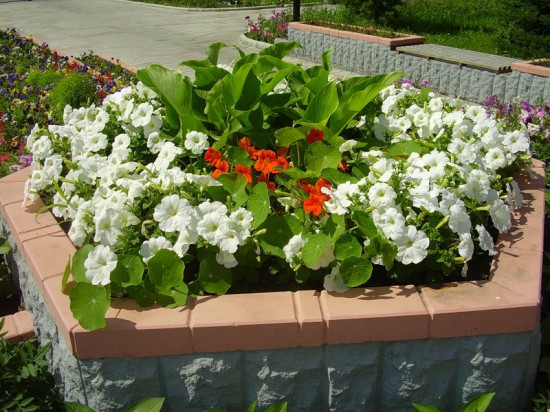
The choice of fencing can be approached creatively, using any obsolete items for the flower bed. For example, old car tires, carts, suitcases, basins, tubs, baskets, etc. Look at similar flower beds in the country house photo:
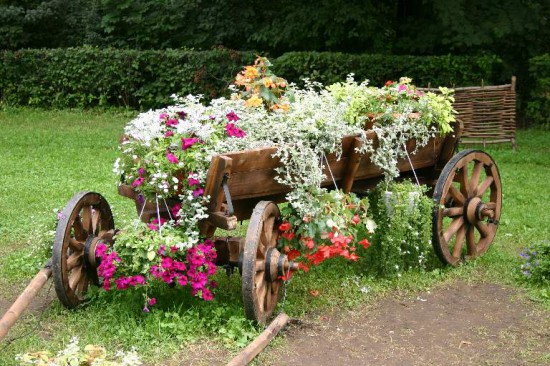
A flowerbed on an old cart is an unusual solution for a country-style garden
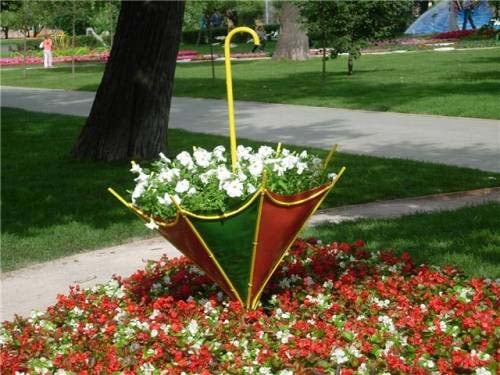
In modern gardens, you can often find compositions in the form of butterflies, animals or other characters. These are multidimensional flower beds, often voluminous and of unusual shape. To make such flower beds in the country with your own hands, you need to work hard, but in general - this is the business of a landscape designer.
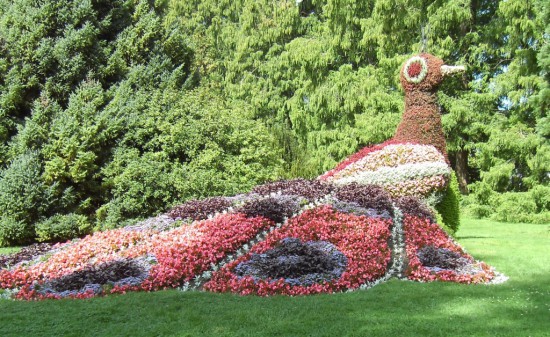
Luxurious peacock spread its tail ... from flowers
Rabatki are another type of flower beds that break along garden paths or alleys. In my own way appearance they resemble stripes 0.5 - 3 m wide from several rows of annual or perennial crops.
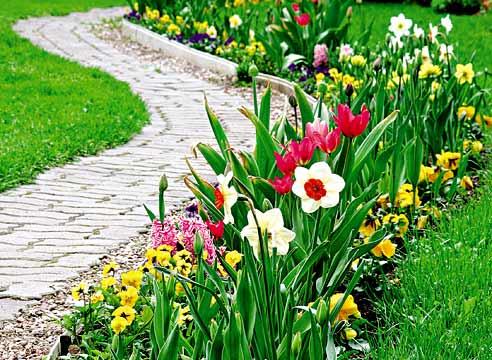
Floral borders look like ridges, but the latter are narrower and rarely reach 0.5 m in width. This is a frame for another landscape object: flower beds, paths, playgrounds, lawns. That is, the border cannot exist independently, but only as an addition to a more significant element.
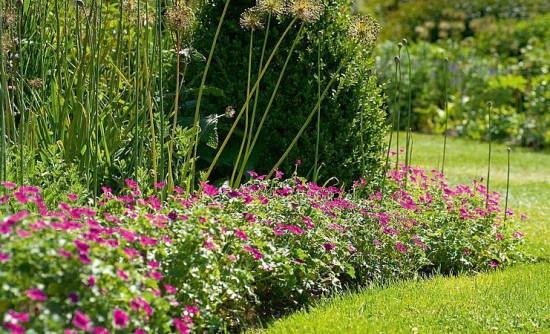
How to make a flower garden in the country if the entire free territory is occupied by concrete paths? Massive containers will come to your aid, which you can fill with earth and grow whatever your heart desires. Even tropical palms! The fact is that with the onset of cold weather, the container can be easily brought into the room, and this allows you to place the most heat-loving crops in them. Such flower beds are called container. Their variety is tiered flower beds, which allow you to place a whole garden in a limited area. In order to bring this option to life, it is necessary to purchase a special container consisting of several (three or four) tiers. They are arranged one above the other according to the principle of a pyramid: at the bottom is the largest container, at the top is the smallest. Tiers are filled with soil and plants are grown in them in the same way as in ordinary "horizontal" containers.
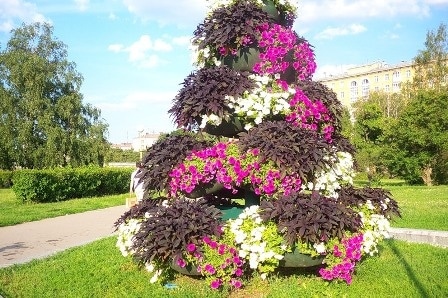
"Flower" content of flower beds
The choice of plants for a flower garden depends entirely on your personal preferences and the style of the site. However, there are certain design trends that you should follow in order to get a decent result.
So, if you like restraint, then you should pay attention to monoflowers. At the same time, plants of either the same species or the same color are selected to create a flower garden. Often this approach is chosen by fans of one flower. For example, if you like roses more than other plants, then why not make a rose garden and become an avid collector of this flower?

Several types of roses can be planted in one single flower garden - rose garden
Such a flower garden in the garden can look very diverse. If monochrome is a priority, then your choice is plants of the same color. For example, red roses, scarlet pelargoniums and crimson petunias can be placed in one flower bed.
For a landscape garden style, mixed flower beds are more suitable, which consist of all kinds of plants. Ground covers, bulbous, shrubs, both annual and perennial, can coexist quite friendly here. A flower garden of perennials consists, as a rule, of both flowering and ornamental deciduous plants. Annual flower beds are brighter, as they consist of lush blooming annuals.
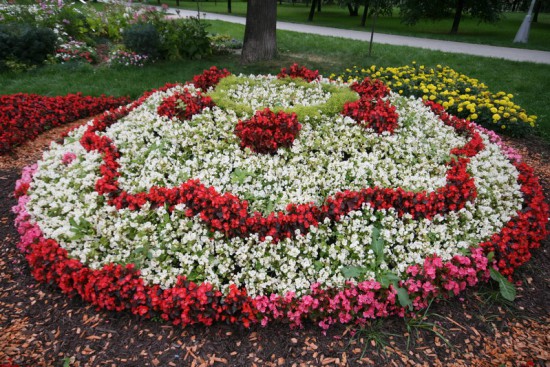
Basic rules of harmonious composition
Flower beds and flower beds in the country are made according to the same principle. First, the dominant plant is selected, which will be the center of the composition. All other flowers are subordinate to the center, therefore, as a dominant, they choose the plant that somehow stands out from the others. Partner plants are located around it, the “appearance” of which is less bright. Next, accentuating elements are planted that emphasize the winning sides of the main flower. This can be done by playing on the contrasts of color, shape, size, texture. The remaining voids in the flower garden are filled with background elements. Most often, ground covers, ornamental grasses, modest meadow grasses, and ornamental deciduous plants with wide leaves act in this capacity.

When planting several flower beds on your site, remember that they should not only be harmonious in themselves, but also be combined with each other, as well as with the style of the garden as a whole. It is desirable to combine all the flower beds on the site into one large composition, using the effect of repeating a certain plant or color in all its elements.
Having decided to plant a flower garden on your site, you will probably view a lot of information. We have selected a wonderful video for you, which tells about the principles of creating a flower garden and little tricks that will be of interest to both beginners and experienced flower growers.
Composing compositions from garden flowers is a troublesome process, but not as laborious as it might seem at first. Flowers for compositions are usually cut in the garden or bought in a store. It is possible to use indoor flowers for interior design. In this case, it is necessary to carefully consider which flowers to use in interior design: whether they will be compositions of violets, ferns or mini-deserts from glass bowls.
In this article, you can see photos of flower arrangements, as well as find out what material to use for flower arrangements. We will also share with you recommendations on how to buy flowers and how to collect plants for arranging a room in your garden.
Acquisition of material for flower arrangements
There are three main sources for acquiring fresh plant material. An important source is the garden, where you can cut fresh flowers that are in the right stage of development for an indoor arrangement. In addition, there is a large supply of stems and leaves, which are so important for almost all compositions.
The main problem is that there are times when there are not enough flowers in the garden, or when you want to make a composition that requires larger and more vibrant flowers than your garden can offer. In this case, you will have to turn to an alternative source. You can collect fresh material in nature, but there is a certain code of conduct. You can collect flowers except for some rare ones which are protected.
There are a number of restrictions - plants must be wild and not planted, they must not be on private land, and they cannot be dug up by the roots. For year-round production of spectacular flowers, you must turn to a third source - flower shops. This could be a garden center, a market stall, or a supermarket.
The filler material consists of small flowers or leaves of all kinds, which are used to cover the fasteners and edges of the container, and also provide additional interest and color to the compositions. They are filled with unwanted exposed areas.
Examples: scabiosa, gravel, hebe, holly, aster, gypsophila, goldenrod, freesia, ivy, euonymus, bouquet carnations.
The basis for compositions of garden flowers - the formation of phytodesign
The shaping material consists of tall stems, spike-shaped inflorescences or expressive leaves that are used to create the main form or frame. The basis for arrangements of garden flowers can be straight or curved, and this sets the height and width of the finished composition.
Examples: boxwood, privet, gladiolus, long-stemmed roses, eucalyptus, jasmine, broom, forsythia, delphinium.
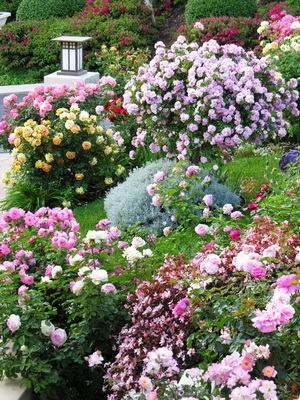
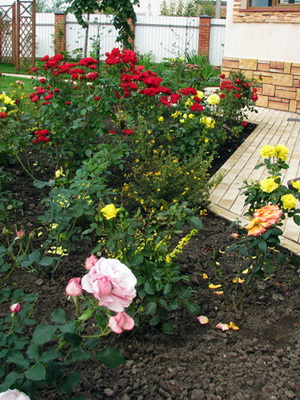
The main material of such a phytodesign consists of large flowers or spectacular inflorescences of small flowers.
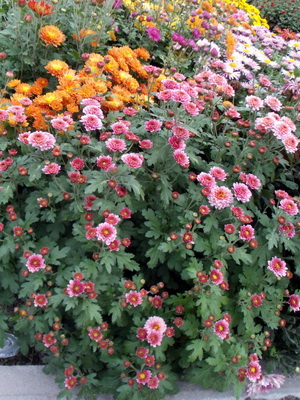
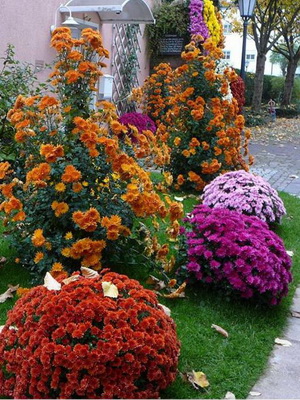
Sometimes attractive foliage is used. This dominant material provides one or more focal points.
How to buy flowers for arrangements
A self-respecting florist or large supermarket chain obviously cares about maintaining their reputation, but you can't rely on one supplier to always outperform others. The only way to judge quality is to look at the material. First, look at the flowers in the buckets - they should be protected from direct sunlight, and the water should not smell bad. The foliage should be resilient, and the cut ends of the stems should be immersed in water.
As a rule, in order for the flowers to stand for a long time, they should be bought in the half-dissolving stage.
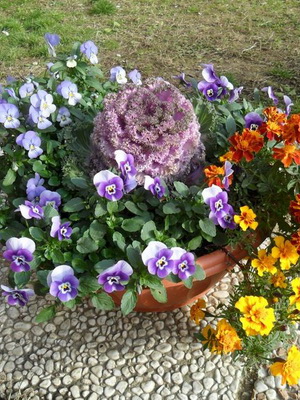
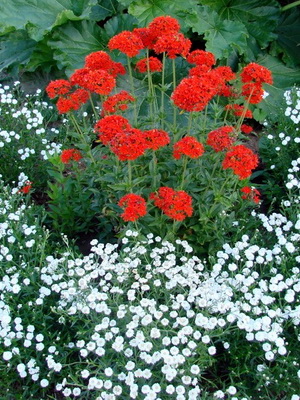
Pay attention to the photo of compositions from garden flowers - there are always several open flowers and many colored buds in the inflorescences. It is too early to buy flowers at the bud stage - dense green buds often do not open indoors. Fully opened flowers will not last long. Of course, this is not a problem if the bouquet is for a special occasion the next day.
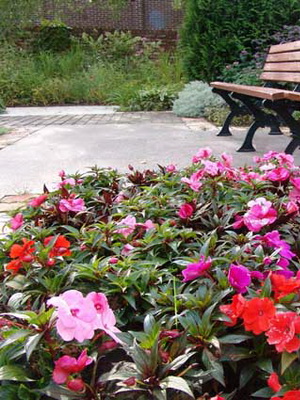

In flowers with simple chamomile inflorescences, the appropriate stage is determined by the fact that the petals are fully open, but the central disc is free of yellow pollen.
Bring flowers home as quickly as possible - don't put them in the trunk of a car on a warm day. Prepare the flowers before using them in the arrangement.
|
PLANTS |
DEVELOPMENT STAGE FOR CUT DURABILITY |
|
ALSTREMERIA |
|
|
CLOVE BOUQUET |
About half of the flowers are open - the buds are swollen and strong |
|
CARNATION |
The flowers are open - no white streaks. Leaves are firm and fresh |
|
CHRYSANTHEMUM |
|
|
CHRYSANTHEMUM |
The flowers are open - the center is dense and the outer petals are elastic |
|
NARCISS NON-Double |
The buds are colored and starting to open |
|
NARCISS TERRY |
Flowers fully open |
|
Several flowers open - buds painted |
|
|
The flowers are open. Central disk greenish - no pollen appeared |
|
|
GLADIOLUS |
Several flowers open - buds painted |
|
gypsophila |
Almost all flowers open |
|
Several flowers open - buds painted |
|
|
Several flowers open - buds painted |
|
|
Flowers fully open |
|
|
Most of the flowers are open - the center is still dense. The buds are painted |
|
|
Opening buds or flowers with a dense middle. Several leaves on stems |
|
|
Almost all flowers open |
|
Garden flowers for composition and photo cut flowers
Go to the garden in the morning or evening with a bucket half full of cool water. Garden flowers for the composition, choose only those that are in the right stage of development, as described in the table below. Don't cut too many stems from newly planted specimens.
There are three rules regarding cutting - the knife, scissors and secateurs must be clean to avoid bacterial infection; blades must be sharp to ensure a clean cut.
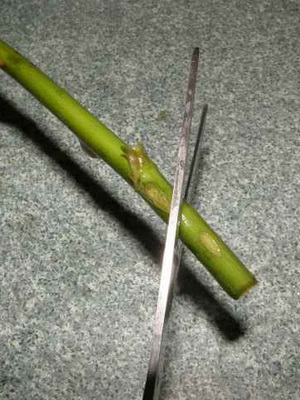
![]()
Pay attention to the photo: the cut of the flowers for the composition should be slanted to provide a large surface area that absorbs water.
Remove quickly lower leaves to be submerged in water. It is especially important that gray or pubescent leaves do not remain in the water. It is important that the cut ends do not dry out - immerse the stems in a bucket as soon as possible and do not keep it in bright sun.
Bring the bucket indoors when the cutting is finished. Plants are not yet ready to be in composition - a preparation process is required. Some flowers and leaves require special pretreatment. All this may seem quite complicated, but it takes a little effort, but it avoids the disappointment of seeing how all the work falls into disrepair after a few days.
From spring to autumn, the garden provides cut flowers, but is also a source of leaves and stems, which are an integral part of many styles.
|
PLANTS |
DEVELOPMENT STAGE FOR MAXIMUM CUT DURABILITY |
|
CUT CROPS |
conditions apply to material grown in the garden |
|
Yarrow |
Flowers fully open |
|
SNAPDRAGON |
|
|
Flowers fully open |
|
|
DAHLIA |
Most of the flowers are open. Central disk greenish - no pollen appeared |
|
DELPHINIUM |
The flowers of most of the inflorescence are open |
|
FORSYTHIA |
The buds are starting to open |
|
DIGITALIS |
The flowers of the lower half of the inflorescence are open |
|
Almost all flowers open |
|
|
The flowers of the lower half of the inflorescence are open |
|
|
Almost all flowers open |
|
|
MOLUCELLA |
Flowers fully open |
|
PELARGONIUM |
The buds in the inflorescence begin to open |
|
The buds are starting to open |
|
|
RHODODENDRON |
Most of the inflorescence is still in bud |
|
SCABIOUS |
The buds are starting to open |
|
SWEET PEA |
Several flowers open - buds painted |
|
The buds are colored - the leaves are not drooping |
Preparing for flower arrangements
Before you start arranging flower arrangements, you need some preparation. Its purpose is to ensure that there is no callus at the bottom of the stems, nor any air blocks along the length of the stems that shorten cut life. This process is known as keeping fresh. Some plant material requires a special pre-treatment step.
Before starting the pre-treatment phase, there is work to be done if the plants have been left without water for some time. Remove about 3 cm from the bottom of each stem, making the cut slanted.
Processing of woody stems. The ends of woody stems require more than just a slanted cut to ensure good water suction. Peel off the bark from the bottom 3-5 cm with a knife, and then make a 3 cm long slit with scissors or a knife. Do not split the ends, as this can lead to a bacterial infection.
Processing withered flowers. Use Processing hot water as a tonic for withered plant material - roses and many woody plants react quickly to this method. Cover the flowers with a paper bag and submerge the bottom of the stems (3 cm) in nearly boiling water for one minute. An additional benefit is the destruction of bacteria.
Processing of drooping stems. A number of flowering plants (for example, lupins) have drooping stems. The usual treatment is to wrap the stems in damp newspaper and then place the bundle in water overnight. Despite processing, tulips can quickly go limp - in this case, floral wire is pulled up through the stem. Poke a hole under each flower.
Processing stems of spring bulbous plants. Tulips, hyacinths and daffodils need special treatment. Cut off the white part of the stem, and make a slanted cut on the green part. Some spring-blooming bulbs produce a sap that shortens the life of other flowers - soak them overnight in a bucket of water before use.
Treatment of stems with milky juice. Some flowering and deciduous plants exude juice that forms a waterproof layer on the wound. The way to solve this problem is to singe with a flame (lighters, matches or candles) the cut end until it turns black. Plants that secrete milky juice, such as poppy, spurge, ferns, dahlias and zinnia, are treated in this way.
Processing of large leaves. First, the leaves are washed in warm water to remove dust and surface plaque. Then immerse in a container of cool water for several hours. Withered flowers can sometimes be revived in the same way. Take out small leaves after an hour and do not use this method on gray or pubescent foliage.
Keeping fresh. A simple task - the stems are immersed in tepid water in a bucket, which is left in a cool and dark place for 2-8 hours. It is often helpful to add a cut flower preservative. For most plants, deep immersion is recommended. Spring-blooming bulbs are an exception - put tulips, daffodils, etc. into shallow water. Do not leave prepared plants on the table - place directly from the bucket into a damp floral sponge or container filled with water.



